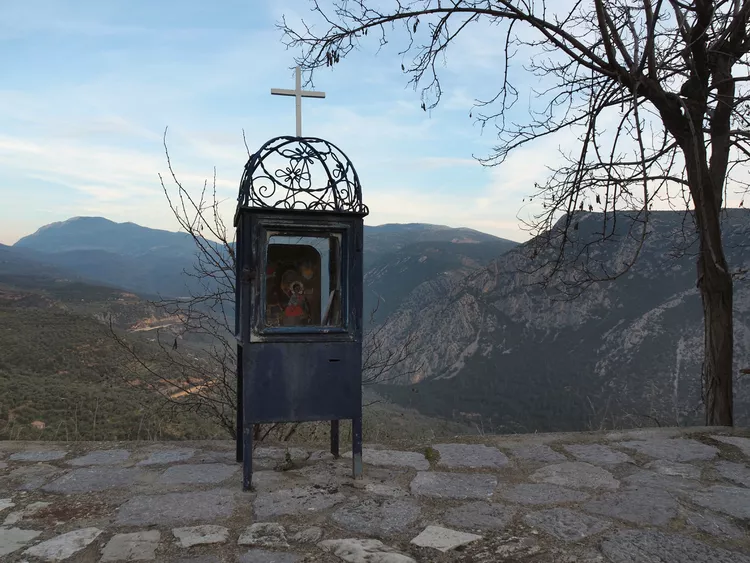Exploring the Roadside Shrines of Greece
Traveling the roads of Greece, it won’t be long until the metal boxes on skinny wire legs catch your attention. It may take a few of them blurring by before you realize what you’re seeing is not a bizarre mailbox or the Greek version of a roadside telephone. Behind the small glass doors, a candle flickers, a color picture of a saint stares back, and the top of the box is crowned with a cross or perhaps a row of Greek letters. Farther along, a brightly whitewashed building the size of a children’s playhouse stands out against the grey-green leaves of the olive trees.
The Origin of the Shrines
Tourists usually assume that the shrine is built to act as a remembrance for a traffic accident victim. This is true in some cases; however, they are often made to publicly thank a saint for a benefit, not commemorate a tragedy. One of the most reliably tended shrines is said to mark the death of a tour bus driver. It stands in front of the entrance to the busy archaeological site of Delphi, where distracted tourists sometimes bump into it. This constant buzz of activity has its benefits, too. If the candle goes out, it is usually only for a few moments—the first driver who notices will go to the shrine, stand a moment in prayer, and light a fresh candle.
Ancient Shrines, New Meanings
Some of the shrine locations may have endured as long as the roads themselves. Nicholas Gage, the author of the bestselling “Eleni,” a tale of his mother’s life in Greece during World War II, writes in “Hellas” about the ubiquitous shrines. He points out that “Shrines to pagan gods were built in the same spots and for the same purpose—to provide the traveler with a moment of rest and prayerful reflection.” They serve a related purpose for travelers who stop for a quick photo opportunity and end up gazing at the endless olive groves disappearing into the distance or find glowing-red cyclamen or yellow crocus unexpectedly bursting through the grass at their feet. Therefore, pausing at these heartfelt roadside shrines immediately connects the visitor with the enduring life of Greece.
The blend of ancient faith and modern practices is often easily visible. An akroterion of Aphrodite is backed by a simple white cross on the top of a Peloponnesian shrine found on the road between Hermioni and Nafplion.
Where to Find the Shrines
Where there is a beautifully built shrine, look at the edges of the groves beyond. There is often an older predecessor, sometimes less carefully tended, but remaining as a testament of past faith.
As family fortunes improve, so do the shrines. In other parts of Greece, the shrines take on the appearance of miniature chapels, sometimes with interior spaces large enough to hold small ceremonies.
Mykonos is famous for its small family chapels, which are usually opened on the feast day of the attendant saint or to commemorate another important day in the family history. A charming chapel stands at the end of the harbor, waiting for last-minute prayers of sailors before sailing on the often-rough waters of the central Aegean. Others are in the heart of the busy, secular streets of the Venezia area.
During your driving trip through Greece, you’ll see ancient temples, impressive Greek Orthodox churches with arching domes, and brilliant gilded icons. You’ll see evidence everywhere of thousands of years of Greek belief. However, to feel it, step inside one of the little chapels. Or stand a moment on a wild roadside by a little shrine where someone’s hopes, pains, or life is perpetually commemorated, and our spirits are restored by a moment of quiet in the heart of Greece.





